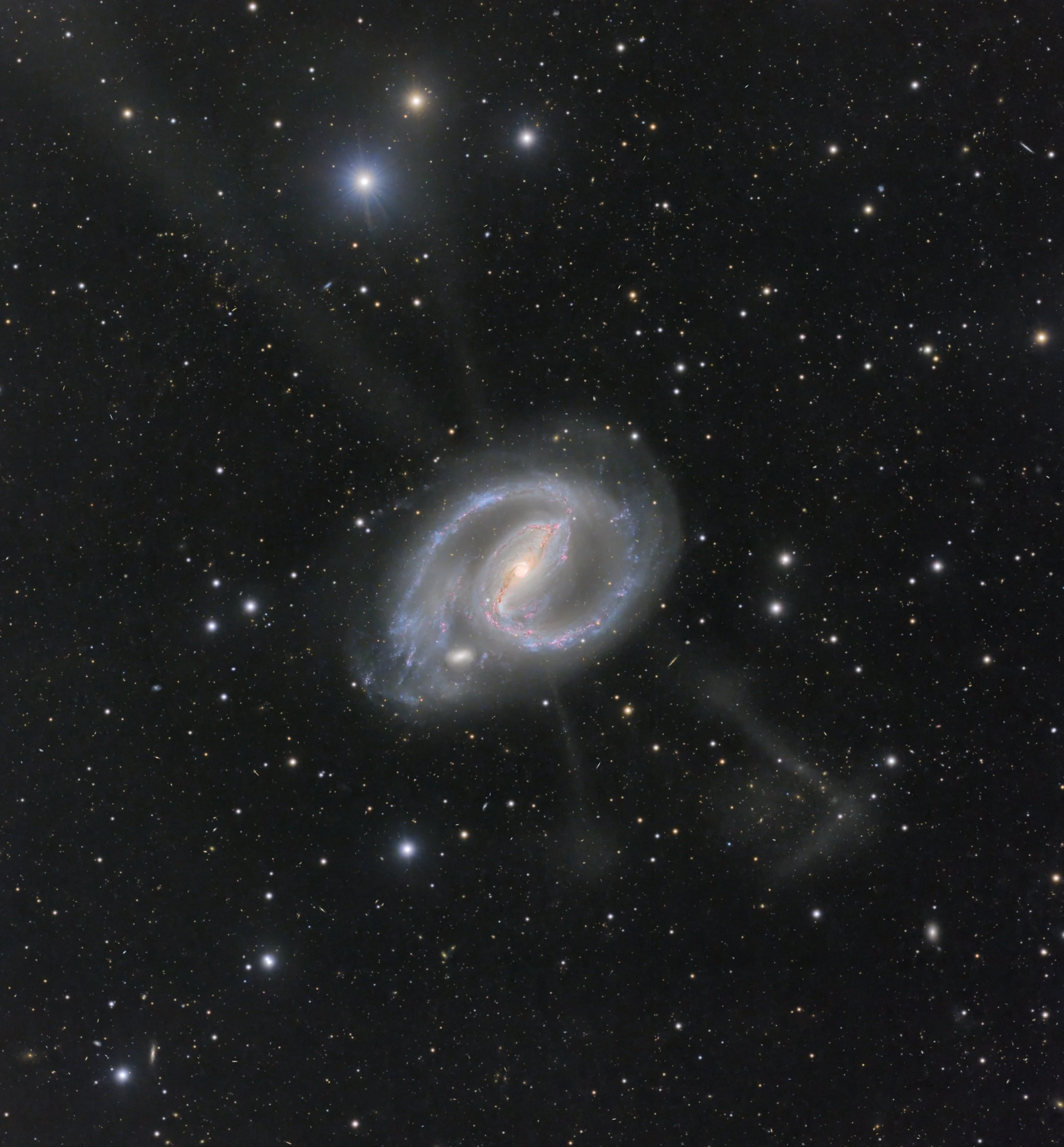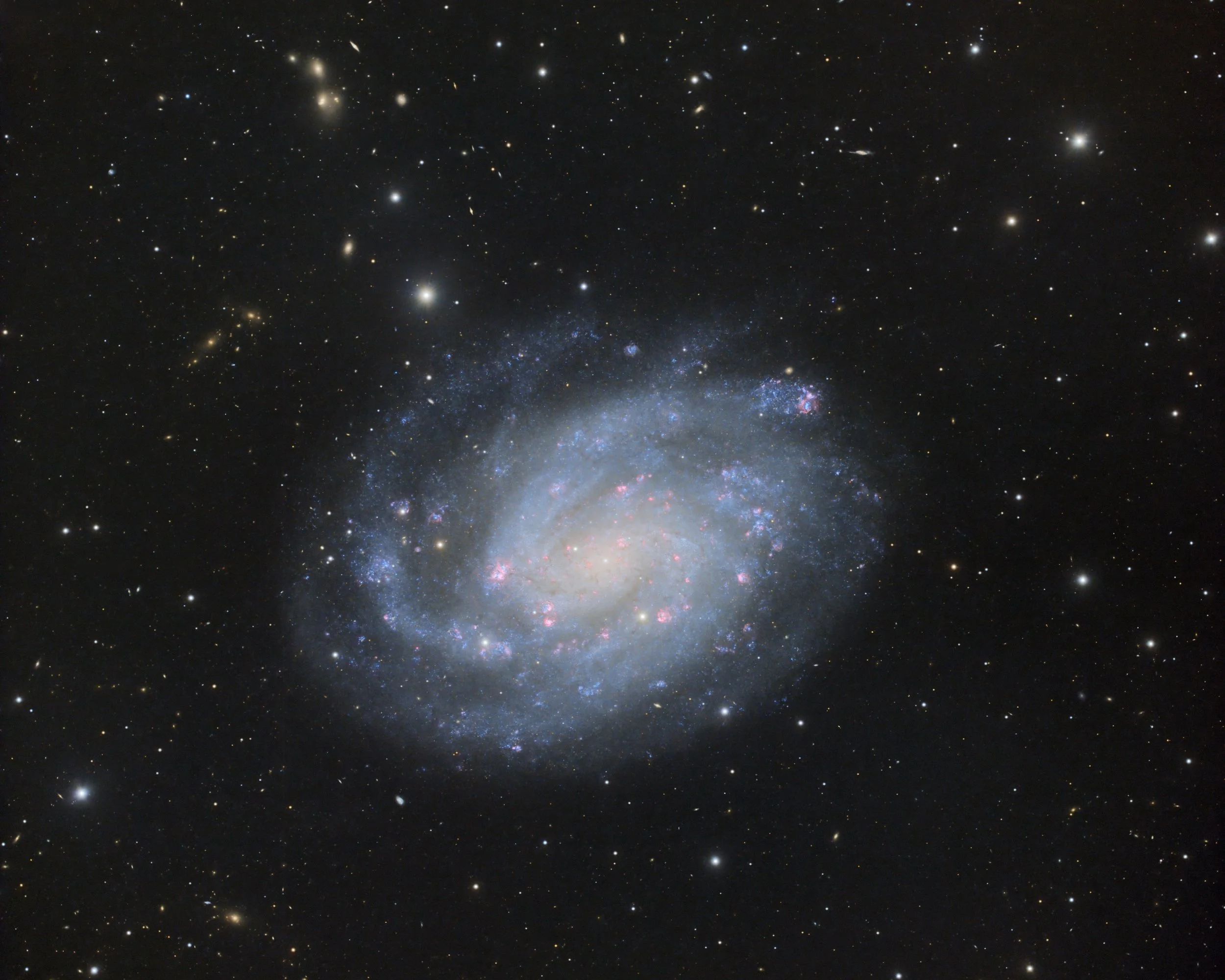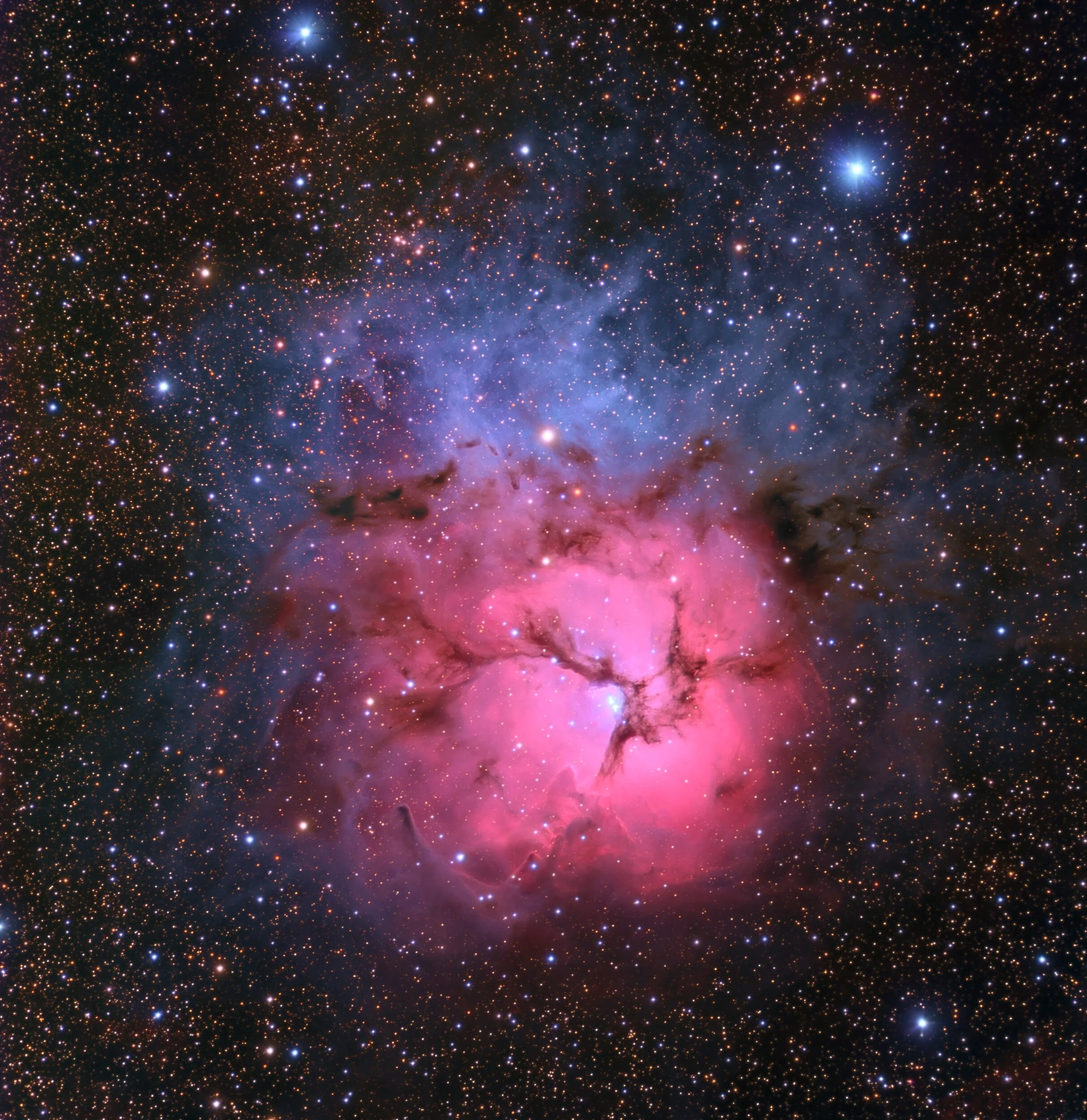
AAPOD2 Image Archives
NGC 1097 - a barred spiral galaxy in Fornax, featuring multiple linear star streams
NGC 1097, nestled in the constellation Fornax, unveils a mesmerizing spectacle of cosmic beauty. This barred spiral galaxy, located approximately 45 million light-years away from Earth, captivates astronomers with its distinctive features, including multiple linear star streams that adorn its spiral arms.
At the heart of NGC 1097 lies a prominent bar structure, consisting of densely packed stars that extend across the galaxy's nucleus. This bar acts as a gravitational anchor, guiding the motion of stars and gas within the galaxy and influencing its overall structure and dynamics. Surrounding the bar, spiral arms adorned with young, luminous stars sweep outward, creating a striking visual display that mesmerizes observers.
NGC 1097's intricate structure and dynamic features provide astronomers with valuable insights into the processes of galaxy formation and evolution. The presence of linear star streams suggests past interactions and mergers with neighboring galaxies, shaping NGC 1097's morphology and enriching its stellar population. As astronomers continue to study this celestial marvel, NGC 1097 stands as a testament to the cosmic forces at play in the vast expanse of the universe, inspiring wonder and awe in all who contemplate its splendor.
NGC 300 - an obliquely angled spiral galaxy in Sculptor
NGC 300, a distant galaxy residing in the southern constellation Sculptor.. This spiral beauty, located approximately 7 million light-years away from Earth, is a breathtaking testament to the vastness of our universe. In this captivating image, NGC 300 unveils its intricate structure, with graceful spiral arms adorned with clusters of brilliant stars.
The galaxy's soft glow is a reminder of the countless stars that populate its disk, where new stars continue to be born amidst the interstellar dust and gas. NGC 300 is a celestial masterpiece, a mosaic of light and color that offers a profound glimpse into the mysteries of the cosmos.
Saturn over the last 6 years (2018-2023)
The excellent seeing of August 29th 2023 allowed me to produce a Saturn image of sufficient quality to add to my montage of images over the ringed planet over the last few years. This made number six (2018 to 2023)
Centaurus A - NGC 5128
The captivating Centaurus A, also known as NGC 5128.
This galaxy, situated within the Centaurus constellation, offers a fascinating amalgamation of scientific phenomena and visual intrigue. At its core resides a supermassive black hole, with a mass of approximately 55 million times that of our Sun, accreting surrounding matter and producing colossal jets of high-energy particles. These jets extend across vast distances, spanning thousands of light-years and emitting radiation in multiple wavelengths, including radio waves and X-rays. Surrounding the galactic nucleus, a dusty disk obscures our view, harboring regions of active star formation and interstellar matter. The complex interplay of these features within Centaurus A provides scientists with valuable insights into the dynamics of galactic nuclei, black hole accretion, and the interplay between star formation and the presence of dust structures. Through meticulous observation and analysis, Centaurus A continues to unveil the intriguing mechanisms governing the universe's most enigmatic objects.
NGC 2029
Image Description and Details : This is a Narrowband image of NGC 2029, which is an area of emission nebulae in the LMC. This is a modified Sulphur II, Hydrogen Alpha, Oxygen III (SHO) image. The SHO combination, conventionally called the Hubble Palette, maps SII to Red, Ha to Green and OIII to Blue. It does however produce quite garish colours and pink stars.The mix is therefore often modified to give a more aesthetically pleasing image, but one where the abundance of the chemical species is still well mapped in a colour image. After some experimentation I went with:
Red: 50% SII + 50% Ha
Green: 20% Ha + 70% OIII
Blue: 100% OIII
I removed the stars with StarXTerminator, before processing the image. Previously I had removed the natural colour (RGB) stars in processing the LRGB image and I was able to use Pixel Math to add them back to this finished image, to give a much more pleasing star field.
The amazing tendrils of gas come through well in this version and I hope you like it, both for its scientific value in mapping the presence of Hydrogen, Oxygen and Sulphur in this region of the sky, but also for its aesthetics.
OTA: C11 EdgeHD
Camera: SBIG 16803
Mount: Paramount MEII
Filters: Astronomik 50mm RGB, Ha, OIII & SII
Exposures:
Ha: 17 x 1800 secs
OIII: 17 x 1800 secs
SII: 16 x 1800 secs
Red: 25 x 600 secs
Green: 24 x 600 secs
Blue: 24 x 600 secs
Total SHO integration: 25 hrs
Total RGB integration (stars): 12.2 hrs
Bias: 35
Darks: 35
Flats: 20
Copyright: Niall MacNeill
M16 - SHO, the Pillars of Creation
Image Description and Details :
This is a Narrowband image of the iconic M16, NGC 6611, using the Sulphur, Hydrogen, Oxygen (SHO) Hubble Palette convention.
Central to the image are the “Pillars of Creation” as detailed in the famous Hubble Space Telescope image.
The result was very different to my previous work with M20 and I have to say, much easier to get an aesthetically pleasing result.I firstly removed the magenta hue. The blue and gold colours were there from the outset but I enhanced these whilst subduing the green. Overall the result is, I think, in keeping with other reference images that use the Hubble palette.
I used Starnet and then Photoshop, using Kevin Morefield's process to end up with a high quality starless image. From there I was able to apply a number of processes such as HDRMT, LHE, and Unsharp Masking, with judicious use of denoising as well as Curves Transformation to improve the sharpness, definition and contrast, evolving the colours to the classic Hubble palette appearance.
I initially added back the SHO stars, dealing with the usual pink halos, but subsequently reprocessed my RGB data to add back the RGB stars. This gave a more natural and colourful appearance to the stars, which integrated very well. I subdued the stars with Morphological Transformation coming to what I think is a nice balance.
Data capture: 2021-08-13 to 2021-09-09
OTA: C14 EdgeHD
Mount: MX+
Camera: SBIG 16803
Filters: Astronomik 50mm unmounted
Lights: 25.5 hours of integration
Ha: 17 x 1800 secs
OIII: 17 x 1800 secs
SII: 17 x 1800 secs
Bias: 35
Darks: 35
Flats 20 per colour channel per camera change
RA/Dec Coordinates
RA 18h18m45.96s
Dec -13°47'55.59"
Copyright: Niall MacNeill
M20 - NGC 6514 - The Trifid Nebula
Image Description and Details :
This is my image of the wonderful and iconic Trifid Nebula. It is about 4100 ly away and is 42 ly across.My 0.54 degree x 0.54 degree field of view, beautifully accommodates it.Capture details:Dates; 2021-04-22 to 2021-05-18Lights: 24.5 hours integrationLum: 32 x 600 secsRed: 23 x 600 secsGreen: 22 x 600 secsBlue: 22 x 600 secsBias: 35Darks: 35Flats: 20 per colour channel per camera changeThere are some very bright foreground stars, which I decided not to reduce too much through Morphological Transformation, as compositionally I feel they add a lot to the image. My image scale and advantageous latitude, which means the object was at a good altitude throughout the imaging runs, plus generally decent seeing meant that good resolution of detail was possible. I was particularly pleased to resolve the stellar jet as imaged by the HST. This is a Herbog-Haro object numbered HH 399.
Copyright: Niall MacNeill
NGC 1532 - a distorted edge-on barred spiral galaxy in Eridanus
NGC 1532 is a most unusual and beautiful galaxy. It is an edge-on barred spiral about 58 million light years away in the constellation of Eridanus.









